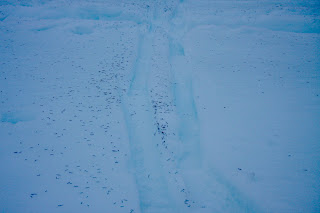 We are documenting this retreat with cameras, but we also measure ice melt and ice velocities. Part of the program was to find the thickness of the ice. For that Andy Aschwanden and I dragged a radar across the ice surface. We found ice that was thicker than 600 m in places. This is quite impressive, because the ice surface had already dropped by about 400 m in some places during the past 100+ years.
We are documenting this retreat with cameras, but we also measure ice melt and ice velocities. Part of the program was to find the thickness of the ice. For that Andy Aschwanden and I dragged a radar across the ice surface. We found ice that was thicker than 600 m in places. This is quite impressive, because the ice surface had already dropped by about 400 m in some places during the past 100+ years.
Andy and I camped on the glacier, and once the sun was low in the sky we were surprised to find the snow surface turning black, as if covered in ash:
 Closer inspection revealed the source: millions of ice worms.
Closer inspection revealed the source: millions of ice worms.
As soon as the wet snow started freezing, they disappeared again, digging themselves into the snow.
After the radar work we spent a few days working near the terminus and on the lake, operating from a beautiful camp site.

And finally, back in Yakutat, we stayed at a beautiful cabin on the beach and enjoyed a well-deserved beer and a camp fire.

The flight back from Yakutat to Anchorage along the coast of Southeast Alaska must be one of the most spectacular flights with a commercial jet, granting views of the most expansive ice cover in North America. First is the pancaked Malaspina Glacier with the enormous Mt. St. Elias in the background (5,400 m).

And then the beautifully sculpted Bering Glacier, the largest glacier in North America, and its big proglacial lake, Vitus Lake.
